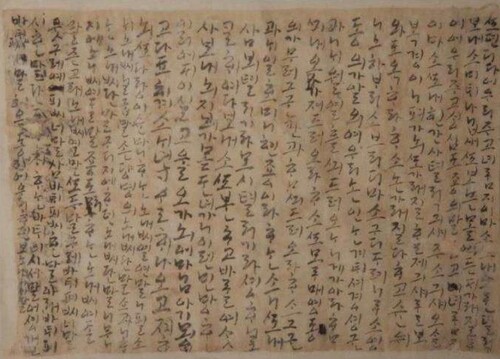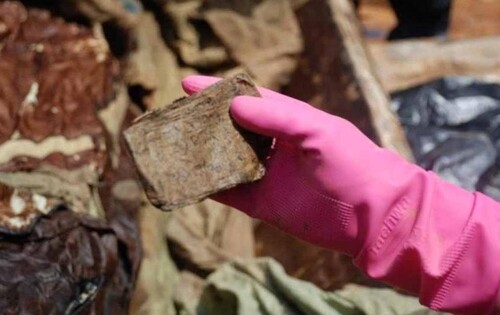 |
▲This photo, provided by the Cultural Heritage Administration, shpws Na Shin-geol's letter. (PHOTO NOT FOR SALE) (Yonhap)
|
 |
| ▲This photo, provided by the Cultural Heritage Administration, shpws Na Shin-geol's letter. (PHOTO NOT FOR SALE) (Yonhap)
|
 |
| ▲This photo, provided by the Cultural Heritage Administration, shows the excavation site of the letter. (PHOTO NOT FOR SALE) (Yonhap) |
SEOUL, December 29 (Yonhap) -- The "Na Shin-geol Hangeul Letter," which is considered the oldest Korean letter ever discovered, will become a National Treasure, one of the nation's state-designated heritage.
The two-page letter written in Korean for his wife by Na Shin-geol (1461-1524), who served as a military officer during the Joseon Dynasty will be designated as a National Treasure, according to the Cultural Heritage Administration announced on December 29.
According to the Cultural Heritage Administration, the letter came from the tomb of Shin Chang-meng, the wife of Na Shin-geol, in Yuseong-gu, Daejeon, in 2011. It was found folded several times by the bedside of the buried body. The letter was excavated along with other relics such as upper garment of hanbok and pants.
The full-page letter with no margins expresses the yearning and worries of the husband towards his wife.
"I was planning to go home and see mother and the children, but I could not. How embarrassing and sad is this situation." (Sentence from the letter restored in 2012).
The letter also includes asking his wife to take good care of farm work and take care of the small family, and to send necessary items such as "Chulik," an official clothing worn by military officials during the Joseon Dynasty.
At the time of writing the letter, Na Shin-geol was working as a junior officer in Hamgyeong-do.
The letter is believed to have been written in the late 15th century. He uses the word "Yeongando," the previous name of Hamgyeong-do, which was used between 1470 and 1498.Na Shin-geol also served as a military officer in Hamgyeong-do in the 1490s.
In the contents of the letter, the word "Yeongando," the old place name of Hamgyeong-do, which was used between 1470 and 1498. Nasin-geul also served as a military officer in Hamgyeong-do in the 1490s.
The letter is evaluated as an important document as it shows how Hangeul was used after 1446, when the Korean script was released. It demonstrates how, just 50 years after the Korean script was released, Hangeul was widely spread and used in rural areas.
It can be assumed that both women and men comfortably used Hangeul at the beginning of Joseon.
It is evaluated as having a high value as it could be utilized for the investigation of the citizen's life, family life, and the history of Hangeul at the time.
The letter, which is considered to have been written 530 years ago, holds high value just by itself.
The "Clothing and the Letter of Suncheon Kim's Family," housed in the Chungbuk National University Museum, was previously thought to be the oldest Hangeul letter.This letter, designated as a National Folklore Cultural Heritage was written in the 16th century, Na Shin-geol's letter was written earlier.
The Cultural Heritage Administration explained, "This letter is the oldest Hangeul letter found in history, and it is an important document that shows the 15th century's Korean practices, such as the way people title each other, and the use of honorifics.
(This article is translated from Korean to English by Dowon Kim.)
(END)
(C) Yonhap News Agency. All Rights Reserved














![[방송 소식] MBC 대학가요제 13년 만에 부활…26일 방송](https://korean-vibe.com/news/data/20251024/yna1065624915904676_716_thum.jpg)
![[신간] 레넌과 매카트니는 경쟁자였을까…'존 앤드 폴'](https://korean-vibe.com/news/data/20251024/yna1065624915904305_293.jpg)







